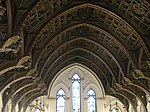Warren Tavern
Buildings and structures in Charlestown, BostonCharlestown, BostonDrinking establishments in Charlestown, BostonRestaurants in Charlestown, BostonTaverns in the American Revolution
The Warren Tavern is reportedly one of the oldest taverns in the state of Massachusetts and one of the most historic watering holes in America. The Warren Tavern was founded in 1780 in Charlestown, Massachusetts and still stands in that block of land today. In the early years of the Warren Tavern it was frequented by many American Revolutionary War heroes such as Paul Revere, Benjamin Franklin, Sergeant David Turner and George Washington.
Excerpt from the Wikipedia article Warren Tavern (License: CC BY-SA 3.0, Authors).Warren Tavern
Pleasant Street, Boston Charlestown
Geographical coordinates (GPS) Address External links Nearby Places Show on map
Geographical coordinates (GPS)
| Latitude | Longitude |
|---|---|
| N 42.37425 ° | E -71.063083333333 ° |
Address
Warren Tavern
Pleasant Street
02129 Boston, Charlestown
Massachusetts, United States
Open on Google Maps









